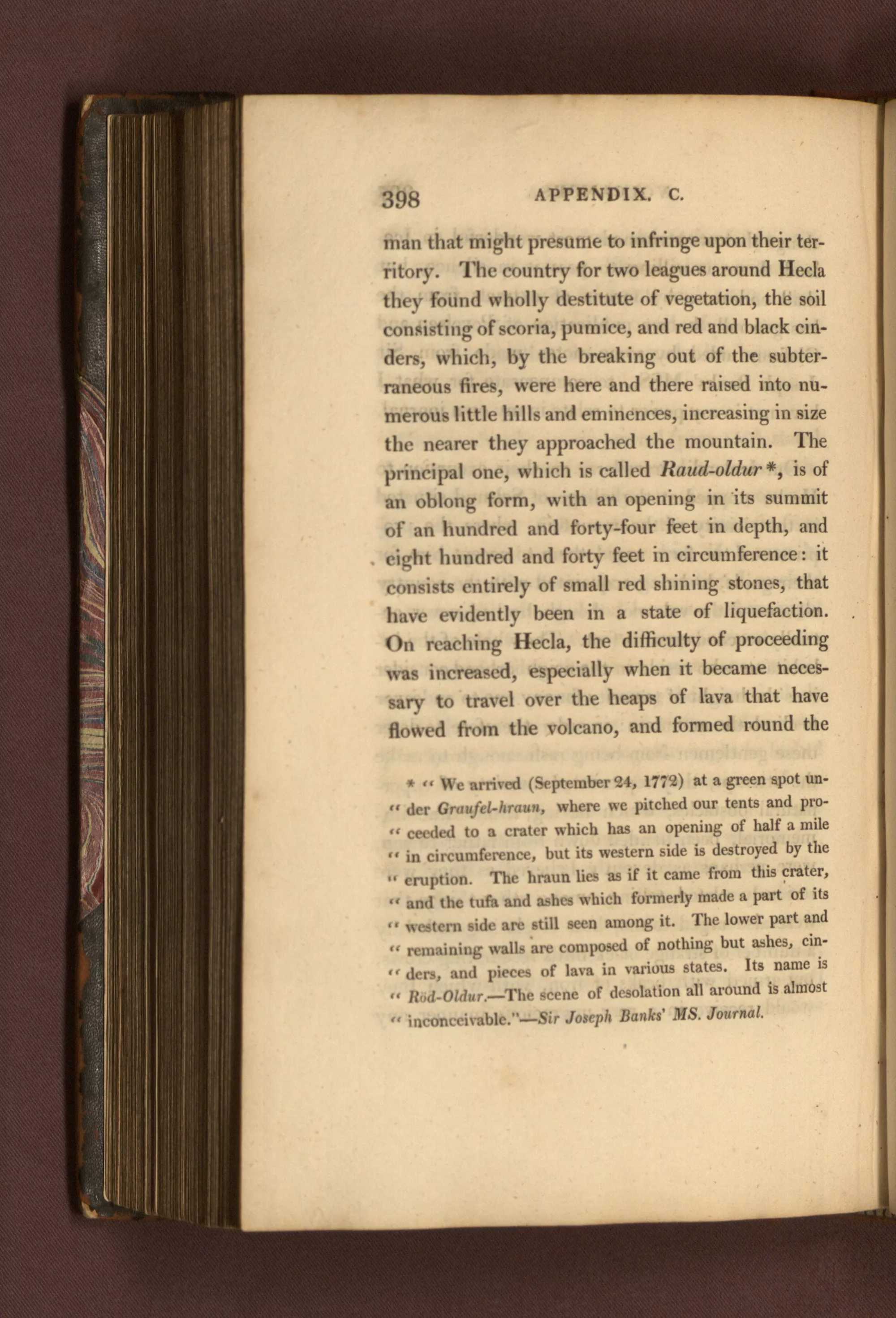Creation Date
1811
Height
5 cm
Width
9 cm
Medium
Genre
Description
As a scientific explorer for King George III, Joseph Banks’ account of the volcano represents how information was recorded during expeditions of volcanoes. This excerpt from Banks’ journal shows how descriptive he is of the mountain. Banks speaks of what materials form the crater; however, unlike modern scientific accounts, the excerpt contains little measurements or precise data. Instead, Joseph Banks focuses on the emotions invoked by the volcano; he writes that “The scene of desolation all around is almost inconceivable.” His focus on the sublime suggests that scientific accounts of volcanoes remained concerned with awe-inspiring depictions, and that science in general was still fascinated by the might and immensity of an often mysterious nature.
Sir Joseph Banks’ journal entry depicts his and William Hooker’s arrival at Mount Helca’s main crater, Raud-Oldur. They stand in a green patch of vegetation to pitch their tents—one of the few areas of vegetation in the crater. All around them is ash, cinder, and lava in various states, the products previous eruptions. This description, a printed excerpt from Sir Joseph Banks’s unpublished journal, appeared in William Jackson Hooker’s Journal of a tour in Iceland (Yarmouth, England: J. Keymer, 1811).
Banks wrote his journal during an expedition on Mount Helca. The only surviving account of the voyage after the fire, William Hooker cites the journal numerous times in his book, Journal of a tour in Iceland. Many of Hooker’s references to Banks’ journal entries are dated “1772”; however, from various accounts given of Sir Joseph Banks and his travels, one can conclude that this date is false. The journal entry must have been written in 1809 as this was the year that Banks made his only voyage to Mount Helca. A copy of Hooker’s book with a printed copy of Sir Joseph Banks’ journal entry was then privately owned by Chester H. Thordarson before arriving in Special Collections at the University of Wisconsin—Madison.
As a scientific explorer for King George III, Joseph Banks’ account of the volcano represents how information was recorded during expeditions of volcanoes. This excerpt from Banks’ journal shows how descriptive he is of the mountain. Banks speaks of what materials form the crater; however, unlike modern scientific accounts, the excerpt contains little measurements or precise data. Instead, Joseph Banks focuses on the emotions invoked by the volcano; he writes that “The scene of desolation all around is almost inconceivable.” His focus on the sublime suggests that scientific accounts of volcanoes remained concerned with awe-inspiring depictions, and that science in general was still fascinated by the might and immensity of an often mysterious nature.
He soon became an accomplished botanist and, with the help of his father (an influential member in the House of Commons), became a scientific advisor to the King. Further inspired by the thought of the Freemasons, Banks traveled on many scientific expeditions, including a voyage to Iceland with his friend, William Hooker. Joseph Banks’ journal of his Icelandic expedition was intended to educate and gratify King George III. The original journal was given only to the king; a few years later, excerpts were reprinted in William Hooker’s book. As a scientist, it was Banks’ duty to write as detailed an account as possible. It is possible that he took measurements that were later burned in the fire and lost at sea, but in his journal he did not take precise scientific notes. Consequently, the function of his journal is not entirely scientific. His sublime depictions of Mount Helca suggest that the journal was instead intended to fulfill King George III’s yearning for awe-inspiring accounts of nature.
Locations Description
House of Commons
Joseph Banks’ father, William Banks, was a prosperous member of the House of Commons. Because of his presence in parliament, William Banks had influence with the royal family. As Joseph Banks gained credibility as a botanist through his academic success, George III appointed him to be one of his scientific advisors and entrusted him to Captain Cook (J. Brook, King George III 223-230).
Raud-Oldur
A local name for the crater on top of Mount Helca, Raud-Oldur is described in Banks’ journal as a place of ash, void of vegetation. Much of the crater’s walls were destroyed by past eruptions (H. Preusser, Landscapes of Iceland 143).
Mount Helca
Classified as a Stratovolcano (one with a tall, multi-layered cone), Mount Helca—also known as Mount Helka—rises to 4,892 feet (1,491 meters). This volcano is Iceland’s most active volcano, and has erupted twenty times since 874 AD. Most of Iceland was formed by this single volcano’s cooled lava, and many of Iceland’s modern inhabitants have settled on the island to study Mount Helca (H. Preusser, Landscapes of Iceland 66).
Copyright
Copyright 2009, Department of Special Collections, Memorial Library, University of Wisconsin-Madison, Madison, WI
Publisher
William Hooker
Collection
Accession Number
Thordarson T3318
Additional Information
Allan, Mea. The Hookers of Kew. London: Joseph, 1967.
Brook, John. King George III. London: Constable, 1972.
Carter, Harold. Sir Joseph Banks, 1743-1820. London: British Museum (Natural History), 1988.
Fisher, Robin, and Hugh Johnston, eds. Captain James Cook and His Times. Seattle: University of Washington Press, 1979.
Lyte, Charles. Sir Joseph Banks 18th Century Explorer, Botanist, and Entrepreneur. Newton Abbot, Devon: David & Charles, 1980.
Preusser, Hubertus. Landscapes of Iceland Types and Regions. The Hague: W. Junk, 1976.
Ridley, Jasper. The Freemasons: A History of the World's Most Powerful Secret Society. Grand Rapids: Arcade Publishers, 2002.

